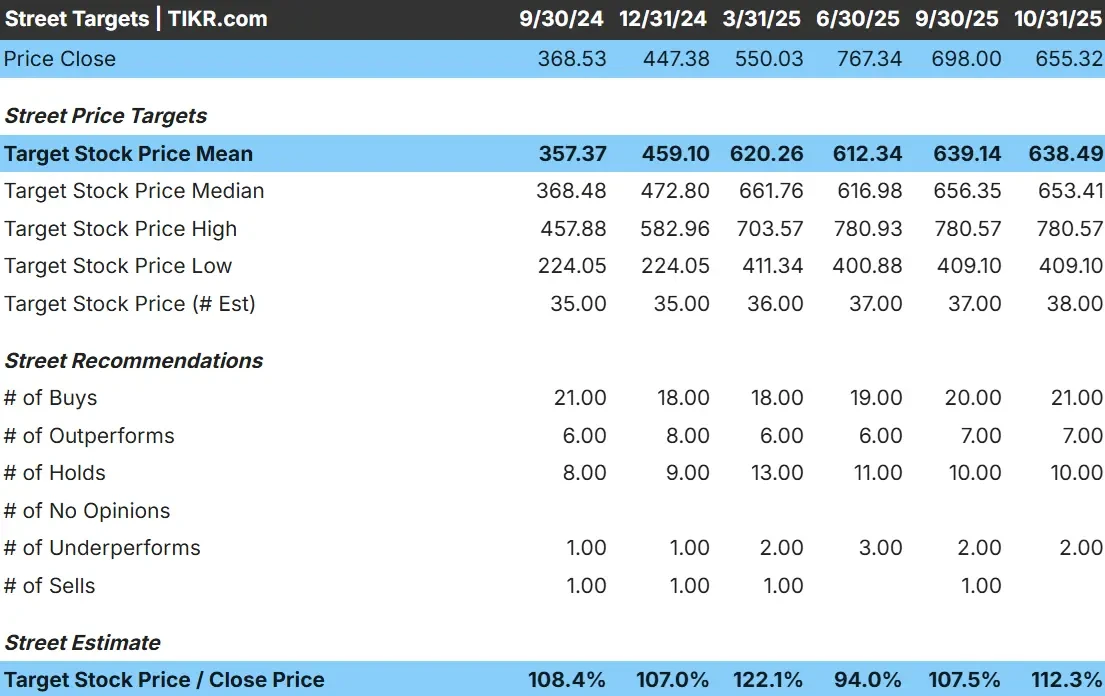Spotify Technology S.A. (NYSE: SPOT) has seen a sharp recovery as investors reward stronger margins and profitable growth. The stock trades near $655/share, up significantly from last year’s levels after management delivered on cost discipline and revenue expansion.
Spotify recently posted strong second-quarter results, highlighting steady user growth and improving profitability. Management pointed to momentum from its expanding audiobook catalog and new AI-driven personalization tools, which are helping deepen engagement and strengthen monetization. These updates show Spotify’s continued shift beyond music streaming toward a broader, more diversified audio platform.
This article explores where Wall Street analysts think Spotify could trade by 2027. We have compiled consensus targets and valuation models to outline the stock’s potential path based on current analyst expectations, not TIKR’s own predictions.
Find out what a stock’s really worth in under 60 seconds with TIKR’s new Valuation Model (It’s free) >>>
Analyst Price Targets Suggest Modest Upside
Spotify trades at about $655/share today. The average analyst price target sits around $638/share, but longer-term models point to roughly 10% upside over the next few years. Forecasts show a wide range, reflecting mixed sentiment among analysts:
- High estimate: ~$781/share
- Low estimate: ~$409/share
- Median target: ~$653/share
- Ratings: 21 Buys, 7 Outperforms, 10 Holds, 2 Underperforms
For investors, this points to modest upside potential as Spotify’s profitability improves and engagement deepens. Analysts appear cautiously optimistic, expecting steady returns driven by operating efficiency and continued growth in premium and ad-supported segments rather than a sharp valuation re-rating.

Discover how much upside your favorite stocks could have using TIKR’s new Valuation Model (It’s free) >>>
Spotify: Growth Outlook and Valuation
Spotify’s fundamentals remain solid, supported by steady revenue growth and improving profitability:
- Revenue growth: projected at ~13% annually through 2027
- Operating margin: expected to reach ~15%
- Forward P/E multiple: ~40x
- Based on analysts’ average estimates, TIKR’s Guided Valuation Model using a 39.6x forward P/E suggests ~$719/share by 2027
- Implied total return: about 10%, or roughly 4% annualized
For investors, this implies Spotify’s valuation already prices in much of its progress. The company is transitioning from a turnaround story to a mature compounding business, with moderate upside tied to operational efficiency and continued global subscriber growth. Unless Spotify delivers stronger earnings leverage or faster ad monetization, returns are likely to stay steady rather than explosive.

See a stock’s true value in under 60 seconds (Free with TIKR) >>>
What’s Driving the Optimism?
Spotify has rebuilt confidence among investors through consistent margin expansion and disciplined execution. Management’s focus on cost efficiency, pricing power, and scalable content investments has meaningfully improved profitability.
The company’s ad-supported business is also gaining traction, growing faster than premium subscriptions as advertisers return to digital audio. Meanwhile, new features like AI-generated playlists and audiobooks for premium users are helping boost engagement and expand Spotify’s ecosystem beyond music streaming.
For investors, these developments suggest Spotify is shifting from growth-at-all-costs to profitable, sustainable growth. Its model is maturing, and the company now appears capable of compounding earnings steadily over time.
Bear Case: Valuation and Competition
Despite these positives, Spotify’s valuation now looks full after its massive rally. Shares trade near 40x forward earnings, leaving limited room for error if growth slows.
Competition from Apple, Amazon, and YouTube remains fierce, and these players can leverage broader ecosystems that Spotify lacks. Rising content costs or slower user growth could pressure margins, especially if advertising demand weakens.
For investors, the risk is that Spotify’s execution must remain strong to justify its current valuation. Any slowdown in subscriber momentum or cost discipline could limit upside and compress multiples.
Outlook for 2027: What Could Spotify Be Worth?
Based on analysts’ average estimates, TIKR’s Guided Valuation Model using a 39.6x forward P/E suggests Spotify could trade near $719/share by 2027. That implies about 10% total upside, or roughly 4% annualized returns from current levels.
While that represents steady progress, it already assumes solid execution and continued margin gains. To deliver stronger returns, Spotify would need to outperform expectations through faster ad growth, broader podcast monetization, or improved pricing power in key markets.
For investors, Spotify looks like a more stable, cash-generating business than it was a few years ago. It may not deliver explosive growth, but its improving fundamentals and disciplined management make it a credible long-term compounder.
AI Compounders With Massive Upside That Wall Street Is Overlooking
Everyone wants to cash in on AI. But while the crowd chases the obvious names benefiting from AI like NVIDIA, AMD, or Taiwan Semiconductor, the real opportunity may lie on the AI application layer where a handful of compounders are quietly embedding AI into products people already use every day.
TIKR just released a new free report on 5 undervalued compounders that analysts believe could deliver years of outperformance as AI adoption accelerates.
Inside the report, you’ll find:
- Businesses already turning AI into revenue and earnings growth
- Stocks trading below fair value despite strong analyst forecasts
- Unique picks most investors haven’t even considered
If you want to catch the next wave of AI winners, this report is a must-read.
Find out what your favorite stocks are really worth (Free with TIKR) >>>








